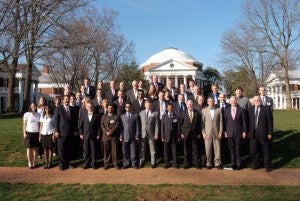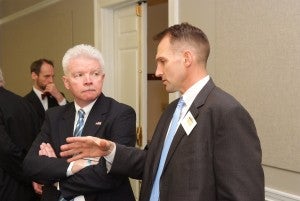Resolving Hostage Crises: Lessons from Colombia

Description
University of Virginia
Charlottesville, Virginia
March 29 – 31, 2009
On February 13, 2003, a plane containing four Americans and a Colombian military officer suffered significant engine failure and was forced to crash land in the jungles of southern Colombia. Upon emerging from the wreckage, the group was attacked by an insurgency group known as the Revolutionary Armed Forces of Colombia (FARC) who, after killing the pilot and the Colombian military officer, took the remaining three Americans as hostages. The Americans were held by the insurgents for over five years before a Colombian military operation named Operation Jaque, Spanish for the chess term, “check,” rescued the three American victims along with several others. The ordeal provided an in-depth case study of the multiple aspects involved in a hostage scenario, and served as a starting point for discussion at the Critical Incident Analysis Group’s twelfth annual conference, “Resolving Hostage Crises: Lessons from Colombia.”
Highlights
Distinguished Guests
- Gary Noesner – Mr. Noesner currently serves as the Senior Vice President in Control Risks North America’s Crisis Management practice. A retired FBI agent, Mr. Noesner completed more than 30 years of duty including serving as Chief of the Crisis Negotiation Unit of the Critical Incident Response Group (CIRG). He has managed more than 120 kidnapping cases.
- Arthur M. Cummings II – Mr. Cummings is the Executive Assistant Director of the FBI’s National Security Branch. In that position, Mr. Cummings oversees the FBI’s Counterterrorism, Counterintelligence, Weapons of Mass Destruction, and Intelligence programs, as well as the Terrorist Screening Center. He is also the lead FBI official responsible for coordination and liaison with the U.S. Director of National Intelligence and the rest of Intelligence Community.
- Paul Galanti – Mr. Galanti was a prisoner of war for nearly seven years in North Vietnam’s infamous Hanoi Hilton complex. In 2002, he was appointed the Director of National Services Officers for the American Ex-Prisoners of War and is currently a service legislative officer for that organization. Galanti serves on both the Secretary of Veterans Affairs’ Advisory Committee on Former POWs and the Board of Virginia’s new Department of Veterans’ Services.
- Marc DeCourcey – Mr. DeCourcey is currently the American National Red Cross Senior Director of Federal Government Relations and Partnerships. In addition, he is the Red Cross representative to the Board of the National Emergency Food & Shelter Program as well as the Council of Federal Executive Secretariats. Mr. DeCourcey previously served as the Chief of Staff of the Office of Legislation and Congressional Affairs for the United States Department of Education.
- Ron Green – Prof. Green is the Faculty Director of Dartmouth College’s Ethics Institute, a consortium of faculty concerned with teaching and research in applied and professional ethics. A member of Dartmouth’s Religion department since 1969, Prof. Green was named a Guggenheim Fellow in 2005.
- John Robb – Mr. Robb, who authored Brave New War in 2007, has been quoted as an expert analytical source by numerous major media outlets such as the New York Times and The Economist. He has leveraged his past experiences as entrepreneur, technology analyst and former U.S. Air Force pilot for special operations to provide a unique analytical view on the technological aspects of terrorism.
- Mark Thompson – As the Deputy Coordinator for Operations in the U.S. Department of State’s Counterterrorism Office, Mr. Thompson and his directorate monitor existing and potential terrorist activities, participating in a variety of interagency counterterrorism efforts. His office also leads the interagency-configured Foreign Emergency Support Team (FEST) which deploys overseas in support of U.S. Ambassadors during terrorist-related events.
- Juan Zarate – Mr. Zarate served as the Deputy Assistant to the President and Deputy National Security Advisor for Combatting Terrorism from 2005 to 2009. In this role, he was responsible for developing and overseeing the effective implementation of the U.S. government’s counterterrorism strategy, including coordinating U.S. efforts to ensure the safe return of American hostages in Colombia.
Key Panels and Discussions
Using the Colombian crisis as a backdrop, the discussion detailed the different types of hostage crises and identified broad principles that pertain to specific settings. In addition, conference participants generated recommendations for dealing with similar future situations. Four broad categories of hostage crises were identified: “regular” criminality; including carjacking and other incidents capable of being handled by local law enforcement; “organized” criminality, characterized by kidnapping for ransom (typically for money); political hostage-taking, characterized by ideological motivations; and mixed-motive hostage-taking. Although most kidnappers initially act for ideological or ransom reasons, the survival and economic advancement of the perpetrator or criminal organization can displace ideological motivations. It is therefore important to understand the perpetrator’s goals more so than the perpetrator’s ideologies.
The majority of kidnappings occur in developing countries, where the capability of law enforcement to react is low and corruption is generally high. As a result, kidnappings in these areas are underreported, as secrecy often expedites victims’ safe returns. In recent years, investigators have also observed an increasing correlation between political violence and crime enabled by technology. The decentralized location and greater anonymity provided by the internet not only allows for an open forum and method of communication that is untraceable, but also enables an open market for profit generation that is without bounds. As one participant summarized, “kidnapping is a growing business.”
Although every hostage crisis is unique, analysis of the Colombian incident yielded several broad principles that can be applied in varying degrees to specific incidents. In a hostage situation, there immediately arise several parties who hold some stake in the outcome of the crisis. These parties include but are not limited to the victim, the victim’s family, and the authorities. Although everyone involved may share the same desire for the safe return of the victim, there may be conflicting interests between the entities which has the potential to be detrimental to the negotiation process. For example, in the Colombian rescue event, disputes between family members at times served to frustrate authorities’ attempts at retrieval. Discord can have a deleterious effect on the negotiation process; therefore, it is essential to have adequate communication between all interested parties.
Communication plays a fundamental role not only in ensuring cooperation between those involved, but also helps to ease the stress associated with the unfamiliar proceedings of a kidnapping scenario. In addition, communication is essential to providing a unified front when dealing with the perpetrators. A single organized effort is much more effective than several, sometimes differing, approaches. Trying to establish and maintain communication with the kidnappers through negotiation can provide important intelligence, including proof of life of the captives, and can effectively stall for time while rescue scenarios are designed.
Adequate response to a hostage crisis can mean the difference between life and death. However, effective preparation can assist in the successful recovery of victims. This preparation involves establishing the capacity for response across several entities that might hold a stake in the outcome, including local and federal governments, non-government organizations (NGOs), and other groups that may be of assistance in countries of high risk. In addition to building these relationships, drafting protocol for crises and providing training for its enforcement is essential to disrupting kidnappers’ attempts at legitimacy. Sufficient preparation can in turn remove much of the incentive for other groups to act similarly.
In the end, the success of a rescue operation may rest on the flexibility of the concerned parties involved. As clear as established protocols may be, conference discussions noted the importance of treating every crisis as a unique situation. Definitive doctrine tends to deter creativity in problem-solving. Adapting to the varying motivations and strategies of kidnappers can help to assure successful restoration of the victims. It is therefore essential to analyze the aspects of each unique hostage crisis and respond accordingly to ensure a favorable outcome.
Representative Insights
“[Terrorist] groups can connect directly to a global economic system, groups that couldn’t do that 20, 30 years ago, call via phone directly to the owner of the ship, negotiate a funds transfer to their location … That’s the big difference, is that these small groups can go straight to the global system without any kind of state intervention or barrier.” – John Robb
“It’s important…to look at the cases in which hostages perhaps [do] not have inherent value, monetary value, or common criminal value, but when they are a vehicle for legitimacy and serve as pawns for strategic end stakes.” – Juan Zarate
“Those in the government who have decision-making authority or responsibility for managing these types of events should be trained in the use of the wide range of tactics, tools, and approaches [that] can address the successful resolution of incidents. One size does not fit all and does not serve us well.” – Gary Noesner
“Once an organization exists, it tries to perpetuate itself… they’ll change their dynamics, they’ll change their purpose, but they’ll try to exist.” – Tyler Rauert
“With Al-Qaeda, the Islamic Maghreb, and to a certain extent … Yemen, you have direct and strategic focus on foreign visitors, Westerners, to be used as a source for funding, but also again for strategic attempt to scare away Western involvement and presence in the Maghreb, as well as the Southern Gulf.” – Juan Zarate
Images
- Participants mingle during the conference’s opening reception.
- John Robb, author of Brave New War, addresses the group.
- John Flood and David Resch discuss a topic raised by the previous session.
- Dr. Eric Stern answers a question during a panel discussion while Juan Zarate takes notes.
- Bernard Barrett responds to a comment as Mats Koraeus observes.
- Mark Kimmitt relates hostage crises to current threats in the gulf of Aden. An international hostage and piracy crisis occurred off the coast of Somalia just a few weeks later.
- Suzanne Spaulding and Steve Herrick react to a comment by Gary Noesner.
- Conference proceedings continue on the final day.








